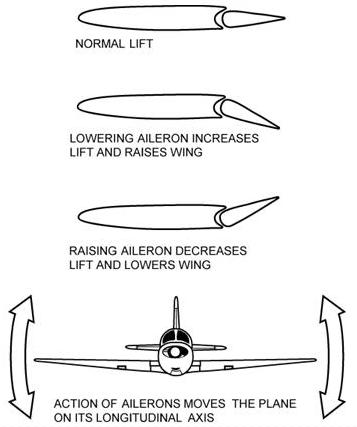1-16
Lateral Control about the Longitudinal Axis
| Lateral control is obtained through the use of ailerons,
and on some airplanes the aileron trim tabs. The ailerons are movable surfaces
hinged to the outer trailing edge of the wings, and attached to the cockpit
control column by mechanical linkage. Moving the control wheel or stick
to the right raises the aileron on the right wing and lowers the aileron
on the left wing. Moving the control wheel or stick to the left reverses
this and raises the aileron on the left wing and lowers the aileron on
the right wing. When an aileron is lowered, the angle of attack on that
wing will increase, which increases the lift. This permits rolling the
airplane laterally around the longitudinal axis. [Figure 1-30]
Many airplanes are equipped with an aileron trim tab which is a small
movable part of the aileron hinged to the trailing edge of the main aileron.
These trim tabs can be moved independently of the ailerons. Aileron trim
tabs function similar to the elevator trim tabs. Moving the trim tabs produces
an effect on the aileron which in turn affects the entire airplane. If
the trim tab is deflected upward, the aileron is deflected downward, increasing
the angle of attack on that wing, resulting in greater lift on that wing.
The reverse is true if the trim tab is deflected downward. |
|
|
Figure 1-30.—Effect of ailerons.
|
Lateral Stability or Instability in Turns
Because of lateral stability, most airplanes will tend to recover from
shallow banks automatically. However, as the bank is increased, the wing
on the outside of the turn travels faster than the wing on the inside of
the turn. The increased speed increases the lift on the outside wing, causing
a destabilizing rolling moment or an overbanking tendency. The angle of
bank will continue to increase into a steeper and steeper bank unless the
pilot applies a slight amount of control pressure to counteract this tendency.
The overbanking tendency becomes increasingly significant when the angle
of bank reaches more than 30°.
During a medium banked turn, an airplane tends to hold its bank
constant and requires less control input on the part of the pilot. This
is because the stabilizing moments of lateral stability and the destabilizing
moment of overbanking very nearly cancel each other out. A pilot can discover
these various areas of bank through experimentation.
Directional Stability about the Vertical Axis (YAW)
Directional stability is displayed around the vertical axis and depends
to a great extent on the quality of lateral stability. If the longitudinal
axis of an airplane tends to follow and parallel the flightpath of the
airplane through the air, whether in straight flight or curved flight,
that airplane is considered to be directionally stable.
Directional stability is accomplished by placing a vertical stabilizer
or fin to the rear of the center of gravity on the upper portion of the
tail section. The surface of this fin acts similar to a weather vane and
causes the airplane to weather vane into the relative wind. If the airplane
is yawed out of its flightpath, either by pilot action or turbulence, during
straight flight or turn, the relative wind would exert a force on one side
of the vertical stabilizer and return the airplane to its original direction
of flight.
Wing sweepback aids in directional stability. If the airplane is rotated
about the vertical axis, the airplane will be forced sideways into the
relative wind. Because of sweepback this causes the leading wing to present
more frontal area to the relative wind than the trailing wing. This increased
frontal area creates more drag, which tends to force the airplane to return
to its original direction of flight.
The combined effects of the vertical stabilizer (fin) and sweepback
can be compared with feathers of an arrow. It would be difficult to imagine
an arrow traveling through the air sideways at any appreciable rate of
speed.
